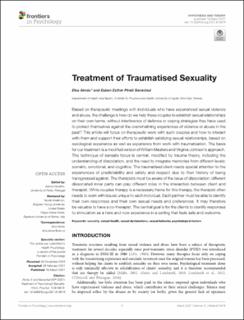| dc.contributor.author | Almås, Elsa Mari | |
| dc.contributor.author | Benestad, Esben Esther Pirelli | |
| dc.date.accessioned | 2021-11-29T12:52:17Z | |
| dc.date.available | 2021-11-29T12:52:17Z | |
| dc.date.created | 2021-08-24T11:36:20Z | |
| dc.date.issued | 2021 | |
| dc.identifier.citation | Almås, E., & Benestad, E.E.P. (2021) Treatment of Traumatised Sexuality Frontiers in Psychology. 2021, 12 1-12. | en_US |
| dc.identifier.issn | 1664-1078 | |
| dc.identifier.uri | https://hdl.handle.net/11250/2831926 | |
| dc.description.abstract | Based on therapeutic meetings with individuals who have experienced sexual violence
and abuse, the challenge is how do we help these couples to establish sexual relationships
on their own terms, without interference of defence or coping strategies they have used
to protect themselves against the overwhelming experiences of violence or abuse in the
past? This article will focus on therapeutic work with such couples and how to interact
with them and support their efforts to establish satisfying sexual relationships, based on
sexological experience as well as experience from work with traumatisation. The basis
for our treatment is a modified version of William Masters and Virginia Johnson’s approach.
The technique of sensate focus is central, modified by trauma theory, including the
understanding of dissociation, and the need to integrate memories from different levels:
somatic, emotional, and cognitive. The traumatised client needs special attention to the
experiences of predictability and safety and respect due to their history of being
transgressed against. The therapists must be aware of the issue of dissociation; different
dissociated inner parts can play different roles in the interaction between client and
therapist. While couples therapy is a necessary frame for this therapy, the therapist often
needs to work with issues unique to each individual. Each partner must be able to identify
their own responses and their own sexual needs and preferences. It may therefore
be valuable to have a co-therapist. The central goal is for the clients to identify responses
to stimulation as a here and now experience in a setting that feels safe and welcome. | en_US |
| dc.language.iso | eng | en_US |
| dc.publisher | Frontiers Media | en_US |
| dc.rights | Navngivelse 4.0 Internasjonal | * |
| dc.rights.uri | http://creativecommons.org/licenses/by/4.0/deed.no | * |
| dc.title | Treatment of Traumatised Sexuality | en_US |
| dc.type | Journal article | en_US |
| dc.type | Peer reviewed | en_US |
| dc.description.version | publishedVersion | en_US |
| dc.rights.holder | © The Author(s) | en_US |
| dc.subject.nsi | VDP::Social science: 200::Psychology: 260 | en_US |
| dc.source.pagenumber | 1-12 | en_US |
| dc.source.volume | 12 | en_US |
| dc.source.journal | Frontiers in Psychology | en_US |
| dc.identifier.doi | 10.3389/fpsyg.2021.610619 | |
| dc.identifier.cristin | 1928271 | |
| cristin.ispublished | true | |
| cristin.fulltext | original | |
| cristin.qualitycode | 1 | |

